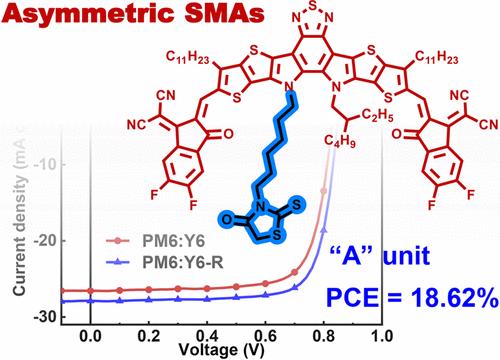Rhodanine Substitution of Asymmetric Nonfullerene Acceptors for High-Performance Organic Solar Cells
IF 8.2
2区 材料科学
Q1 MATERIALS SCIENCE, MULTIDISCIPLINARY
引用次数: 0
Abstract
Asymmetric substitution is acknowledged as a straightforward yet potent approach for the optimization of small molecule acceptors (SMAs), thereby enhancing the power conversion efficiency (PCE) of organic solar cells (OSCs). In this work, we have successfully engineered and synthesized a novel asymmetric SMA, designated as Y6-R, which features a rhodanine-terminated inner side-chain. In devices with PM6 as the polymer donor, the asymmetric Y6-R demonstrated an impressive PCE of 18.62% with an open-circuit voltage (Voc) of 0.863 V, a short-circuit current (Jsc) of 27.89 mA cm–2, and a fill factor (FF) of 77.35%, which is much higher than that of the symmetric SMA Y6-based devices (16.84%). The superior performance for PM6:Y6-R devices can be attributed to a combination of factors, including the upshifted LUMO energy levels, more desired exciton dissociation, collection, and extraction capability, as well as reduced recombination and suppressed Eloss. In addition, the Y6-R molecules promote the more desired coaggregation behaviors along with the donor, endowing the stronger and more ordered crystallinity of blend films. Our findings underscore the effectiveness of rhodanine-substitution, as a representative of “A” units, of the asymmetric SMAs in fine-tuning the coaggregation behavior with the donor, thereby enhancing crystallinity and efficiency.

非对称非富勒烯受体罗丹宁取代在高性能有机太阳能电池中的应用
不对称取代被认为是优化小分子受体(sma)的一种简单而有效的方法,从而提高有机太阳能电池(OSCs)的功率转换效率(PCE)。在这项工作中,我们成功地设计和合成了一种新的不对称SMA,命名为Y6-R,其特征是罗丹宁末端的内侧链。在PM6为聚合物供体的器件中,不对称Y6-R的PCE为18.62%,开路电压(Voc)为0.863 V,短路电流(Jsc)为27.89 mA cm-2,填充因子(FF)为77.35%,远高于对称SMA y6器件(16.84%)。PM6:Y6-R器件的优异性能可归因于多种因素的组合,包括LUMO能级的提升,更理想的激子解离、收集和提取能力,以及减少的重组和抑制的损耗。此外,Y6-R分子促进了与给体更理想的共聚集行为,赋予共混膜更强和更有序的结晶度。我们的研究结果强调了罗丹宁取代作为“a”单元的代表,在微调与供体的共聚集行为方面的有效性,从而提高了结晶度和效率。
本文章由计算机程序翻译,如有差异,请以英文原文为准。
求助全文
约1分钟内获得全文
求助全文
来源期刊

ACS Applied Materials & Interfaces
工程技术-材料科学:综合
CiteScore
16.00
自引率
6.30%
发文量
4978
审稿时长
1.8 months
期刊介绍:
ACS Applied Materials & Interfaces is a leading interdisciplinary journal that brings together chemists, engineers, physicists, and biologists to explore the development and utilization of newly-discovered materials and interfacial processes for specific applications. Our journal has experienced remarkable growth since its establishment in 2009, both in terms of the number of articles published and the impact of the research showcased. We are proud to foster a truly global community, with the majority of published articles originating from outside the United States, reflecting the rapid growth of applied research worldwide.
 求助内容:
求助内容: 应助结果提醒方式:
应助结果提醒方式:


